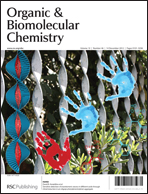Photochemical and photophysical behavior of indolyl anions in photostimulated intramolecular arylation reactions†‡
Abstract
O-Arylation reaction is obtained when N-(2-halophenyl) indolo carboxamides are irradiated in a basic medium. On the basis of photochemical and photophysical experiments, we propose that 2-indolylbenzoxazole is formed by intramolecular electron transfer followed by fast dehalogenation of the halophenyl radical anion pendant moiety, finally a radical–radical collapse renders the observed product.


 Please wait while we load your content...
Please wait while we load your content...